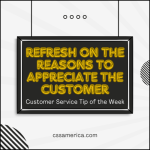We are fortunate to have a lot of professional sports clients. Typically when working with these organizations, the dual focus is season-ticket holder retention and sales growth. Many teams focus on creating synergies between their services area and their sales area. It is not just important for pro sports teams; it is also important for any organization. Let’s stick with the pro sports analogy to illustrate the point.
One key term used in the business side of pro sports is the need to create “synergies” between departments. In particular, one of the biggest potential areas of synergy is the service area creating sales leads for the sales division. This is a situation where service personnel identify potential group sales, event sales, or ticket sales through the relationship they have with their existing season-ticket holders. The service areas then send these leads to the sales departments to close. The synergies not only help the organization to perform better financially, but they help your organization to quickly generate sales by having the sales be created through leads generated from the greatest referral source there is – your current clients.
But thinking a little out of the box in terms of the relationships between these two areas, one great way where service and sales need to talk is where the education of one group by the other will pay dividends to the company. For example, salespeople know how to sell. They know the strategies, the mental decision trees, and the techniques to utilize. While many customer service people may detest selling, they must also realize that to do the best job possible in serving their clients, they need to periodically make offers on products and services to help address client needs. You’re actually doing a disservice if you don’t sell to some of your clients because they’re not getting their needs met. The sales personnel need to train service on key selling techniques.
Similarly, service needs to train sales. Sales people often think in a very transactional manner. While some are very process or relationship oriented, many more don’t understand how to think long-term and how to develop relationships using a long-term strategy. Service people in pro sports teams understand the concept of Touch Point Planning. They understand how to develop a relationship over time, viewing your customers as suppliers of information that will help you to retain them and sell to them in the future. Service personnel can teach sales folks how to be very disciplined and how to structure communication points with their clients, realizing that they need to get information from the customers in order to best sell to the customers.
While there are many organizations that experience friction between service and sales, the organizations that are most effective are those where service and sales talk with and teach each other.
Interested in improving your company’s customer service? See more information at: http://www.cssamerica.com/





















